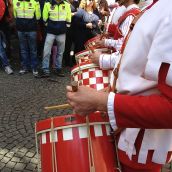Tags
Andrew Lloyd Webber, Corpus Christi, Gian Lorenzo Bernini, Italy, jesus christ superstar, joseph and the amazing technicolor, Orvieto, Pope Urban IV, ted neeley, Travel
Medieval Times
On June 1, I traveled to Orvieto, to check out the annual historic and religious procession in this ancient Umbrian town for Corpus Domini (also known as Corpus Christi). In 1264, Pope Urban IV established the holiday from Orvieto, where he was living at the time, which is one reason why the event is the most important to the Orvietani, following Christmas and Easter.
I’m not a Catholic, so once again this was a great learning experience (and for any Catholics who may read this, mea culpa in advance for anything I get wrong! I never went to Sunday school. Instead I got most of my religious education from Andrew Lloyd Webber: “Jesus Christ Superstar,” “Joseph and the Amazing Technicolor Dreamcoat”—religion seems to me a strange thing, mystifying).
So back to what I learned on this search (and sadly, Gian Lorenzo Bernini, my 400-year-old boyfriend, doesn’t have much to do with Orvieto, so he doesn’t really figure in this search): Pope Urban IV established Corpus Domini as a holiday to encourage commemoration of the Eucharist, established at the Last Supper, when Jesus reportedly consecrated bread and wine and gave them to his disciples, saying, “this is my body,” and “this is my blood,” and urged his followers to repeat the rite in his memory.
Pope Urban hoped the new holiday would stanch some of the “heretical” movements at the time and reinvigorate deference for the Eucharist.

A tapestry depicting the Miracle of Bolsena
This year, 2013, marked the 750th anniversary of the Miracle of Bolsena, which seems to have prompted Pope Urban’s idea to create the new holiday. The miracle occurred in 1263, when a doubting priest, while celebrating Mass in Bolsena, looked down and found his hands covered in blood. The blood had begun to drip from a consecrated statue of Jesus. The parishioners delivered a cloth used to collect the blood to Pope Urban in Orvieto, who absolved the shaken (and presumably now-committed) priest.
(The journey of the cloth from Bolsena to Orvieto is recalled with a midnight walk during Corpus Domini, which my friend and newly minted Orvietana, Toni DeBella, completed this year. All six hours of it. In the pouring rain and through muddy forests in the pitch black. Arriving around 6 a.m.—for Mass. You can check out her story about it on Italian Notebook.)
And so, as part of Orvieto’s Corpus Domini procession, the holy cloth—which is kept safely protected in the duomo the other 364 days of the year—is accompanied through the town by a parade of citizens in jewel-toned costumes.
It’s a true living history event. With some dramatic entrances:
On Saturday afternoon, the festivities begin with the Corteo delle Dame e dei Popolani (Parade of Ladies and Peasants). They’re accompanied by drummers and the occasional bagpipe.
Orvieto was (and is) divided into four quarters—Corsica, Serancia, Olmo and Santa Maria della Stella—each represented by different flags (I don’t believe these below represent the four, but it gives you the idea).
Unlike the Corteo delle Donne, which included some men, on Sunday, the parade consists exclusively of men (natch!). But some of them were just as pretty to look at.
The procession includes representations of the municipal courts of the time, coats of arms and weapons of the noble families of Orvieto.
Also represented are the various guilds of the town, from barbers to ironworkers, bookmakers and vintners. They all have their own colorful banner.
At the duomo, at the end of the day, priests ceremoniously return the sacred cloth for safekeeping—accompanied by a crowd of devoted citizens who form a candle-light parade inside the magnificent cathedral, while the impressive organ booms out notes from what I think is Handel’s “Messiah.”
If you want to hear a tiny snippet of the organ music, click here! Ciao!




















We missed the Corpus Christi celebrations but what a beautiful city! A real treasure, and seemingly off the beaten track for many tourists.
LikeLike
I was in Orvieto in May and while I was there we also observed a similar parade that we were told was to celebrate Corpus Christi…. it is indeed a beautiful city and it was a real joy to see this celebration!!
LikeLike